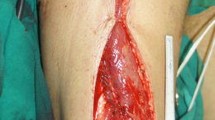Abstract
Background
Primary suture closure of wounds is often the optimal solution for soft tissue defect closure because of its simplicity and satisfactory outcome, yet it may be impeded by high -tension closure. The customary application of skin grafts, flaps, free tissue transfer, or tissue expansion is often associated with relatively more complex surgical reconstructive procedures, significant morbidity and extended hospitalization and prolonged recovery period.
Methods
We retrospectively investigated all patients who underwent wound closure using a mechanical wound closure device between 2014 and 2016 in a tertiary hospital center. The device consisted of stainless steel hooks, sutured over the opposite wound edges, and rubber bands for generating tension which is gradually increased. Approximated wound margins were sutured or allowed to heal by secondary intention.
Results
The mechanical device was applied in 50 patients. There were 38 males and 12 females. Wound size ranged from 3 to 25 cm. In most of the patients there was a satisfactory wound margin approximation. However, in 6 patients skin hook cut through from wound margins occurred due to excessive rubber band tension. In 5 patients, it was decided to also apply negative-pressure wound therapy along with the device. After application of the wound closure device, a residual raw area remained in other 4 patients in whom a split thickness graft was applied. During follow-up, hypertrophic scar and wound dehiscence were found in 5 patients.
Conclusions
The mechanical wound closure device herein presented is a simple and inexpensive technique that allows a significant reduction in surgical costs and surgery-related morbidity.
Level of Evidence: Level IV, therapeutic study.




Similar content being viewed by others
References
Antonyshyn O, Gruss JS, Zuker R, Mackinnon SE (1988) Tissue expansion in head and neck reconstruction. Plast Reconstr Surg 82:58–68
Bauer BS, Few JW, Chavez CD, Galiano RD (2001) The role of tissue expansion in the management of large congenital pigmented nevi of the forehead in the pediatric patient. Plast Reconstr Surg 107:668–675
Verhaegen PD, van der Wal MB, Bloemen MC, Dokter J, Melis P, Middelkoop E et al (2011) Sustainable effect of skin stretching for burn scar excision: long-term results of a multicenter randomized controlled trial. Burns 37(7):1222–1228
Shelley OP, Dziewulski P (2006) Late management of burns. Surgery 24:15–17
Agha R, Ogawa R, Pietramaggiori G, Orgill D (2011) A review of the role of mechanical forces in cutaneous wound healing. J Surg Res 171:700–708
Topaz M, Carmel NN, Silberman A et al (2012) The TopClosure® 3S system, for skin stretching and a secure wound closure. Eur J Plast Surg 35:533–543
Topaz M, Carmel NN, Topaz G, Zilinsky I (2014) A substitute for skin grafts, flaps, or internal tissue expanders in scalp defects following tumor ablative surgery. J Drugs Dermatol 13:48–55
Gibson T, Kenedi RM, Craik JE (1965) The mobile micro-architecture of dermal collagen. Br J Surg 52:764–770
Armstrong DG, Sorensen JC, Bushman TR (1995) Exploiting the viscoelastic properties of pedal skin with the sure closure skin stretching device. J Foot Ankle Surg 34:247–253
Gibson T (1990) The physical properties of skin. In: McCarthy J (ed) Plastic surgery, vol 207. W.B. Saunders, Philadelphia, p 220
Stark HL (1977) Directional variations in the extensibility of human skin. Brit J Plast Surg 30:105–114
Austad ED, Rose GL (1982) A self-inflating tissue expander. Plast Reconstr Surg 70(5):588–594
Pasyk KA, Austad ED, McClatchey KD, Cherry GW (1982) Electron microscopic evaluation of guinea pig skin and soft tissues “expanded” with a self-inflating silicone implant. Plast Reconstr Surg 70(1):37–45
Author information
Authors and Affiliations
Corresponding author
Ethics declarations
Conflict of interest
G. S. Kalra, Manohar K. Malviya, Ghisulal M. Choudhary, Vipin K. Barala declare that they have no conflict of interest.
Patient consent
Informed consent was obtained from all individual participants included in the study.
Ethical approval
For this kind of retrospective study formal consent from a local ethics committee is not required.
Funding
None.
Rights and permissions
About this article
Cite this article
Kalra, G.S., Malviya, M.K., Choudhary, G.M. et al. Non-surgical wound closure—a simple inexpensive technique. Eur J Plast Surg 41, 81–88 (2018). https://doi.org/10.1007/s00238-017-1321-z
Received:
Accepted:
Published:
Issue Date:
DOI: https://doi.org/10.1007/s00238-017-1321-z




